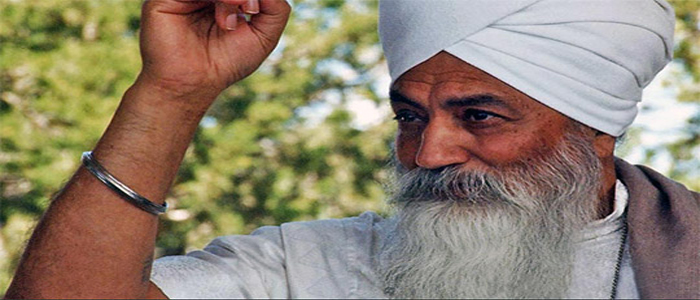This chapter includes … Teaching in Specialized Settings-Finding Our Niche Teaching the Adult Population-Community & Fitness Centers 296 “You must as a teacher concentrate on your mission. ” -YOGI BHAJAN Academic Institutions • Pre-Natal & Post-Natal Yoga • Teaching Children Teachings Seniors • Teaching People with Physical & Mental Health Problems Addiction Recovery Programs • Stress Management & Relaxation • Corporate Challenging Situations in Class 299 Common Questions & Comments from Students 300
THERE ARE CHALLENGES IN TEACHING KUNDALINI YOGA, and we know how to prepare for them through daily sadhana and lifestyle choices. There are also many practical challenges in finding a teaching niche. creating or adapting the environment in which we teach. and in handling unusual problems in classes. Teaching in Specialized Settings Finding Our Teaching Niche How can we tailor a class for different groups of people? The IKYTA directory lists specialties of many teachers-contact them for information about teaching materials that may have already been created. or specialty courses that may be offered. You can search the online KRI Certified List of Kundalini Yoga Teachers to find out who is teaching in any specialty at www.kundaliniyoga.org. You can put in the word “seniors,” or “women’s” or “prenatal” or “childrens,” etc. to find out who is teaching what. People with specialties can also form study groups to exchange experiences and develop teaching materials. There is much material from Humanology as taught by Yogi Bhajan that fits into yoga classes for special interest groups such as addiction recovery groups, corporate groups, and healthcare groups. Following are some examples and general tips for approaching teaching in these specialized areas. Teaching the Adult PopulationCommunity & Fitness Centers, and Academic Institutions These are great places to begin teaching. Many people will go to an institution they know and trust, but they might not go to a course advertised in New Age magazines or health journals. Also you will meet a great variety of people with interesting backgrounds and fitness levels. And you can begin to create a mailing list for future use. There are many recreation places in cities. and the staff are always looking for new and innovative programs. At the same time, they are looking for trends that will be popular. that will fill up the spaces in their facilities all day and evening most days of the week. Yoga classes do well on Monday to Thursday evenings. Other forms of yoga may be occupying these evenings, but situations change quickly, and after you have started teaching, you may be able to switch to a more favorable time. Depending on location, it may take a while to establish a class at other times of the day, unless you teach where there is daycare or a seniors population. These institutions generally look for six to ten week sessions • 296 • KRI INTERNATIONAL TEACHER TRAINING MANUAL LEVEL I of an hour to an hour and a half. You can also try one day or half-day workshops on the weekends. It is best to link your sessions closely to the advertising they do in the community-often a recreation guide is mailed out three or four times a year. Methods of payment vary. Suggestions: Visit several facilities and to assess if they suit your needs. Check out the classrooms and see if the environment will work. • Approach management in places that are a good fit. You can make contact by phone. letter. fax. e-mail. or cold call. Approach with a cover letter addressed specifically to one contact person. a proposal, and a resume. A business card and brochure can be helpful but are not essential. Beginning Kundalini Yoga and Meditation are excellent courses to propose initially. Yoga for Seniors works well in some centers. though they may be looking for volunteers. If you stay with one institution. you can build up more advanced or specialized series later. Pre-natal Yoga The energy of a pregnancy yoga class is different from the energy in other Kundalini Yoga classes. The pregnant woman has a Navel Center that is very open. and she is extremely sensitive. Generally the classes are more supportive and gentler. so as to provide a support system for the pregnant woman who is undergoing constant changes. Women are encouraged to be easy on themselves during pregnancy. Remember that even the limitations for doing yoga while pregnant are written for yogis! You may make adjustments if the pregnant woman has never done any exercise. Make sure she gets permission from her doctor. It is very appropriate to teach techniques of relaxation. breathing, meditation, and gentle yoga . Always remind the pregnant student to listen to her body and to rest when necessary, even if the exercise is not finished. She should not exercise to the point of exhaustion. The following exercises should not be done during pregnancy after the !20th day, or if a woman has any medical complications: Refrain from exercises which apply pressure to the abdominal area. (i.e. Bow Pose. etc.) Refrain from exercises and pranayam that over-stimulate. No Breath of Fire. Yogi Bhajan has stated that light Breath of Fire in the first 3 months is permissable if health permits. She should check with her doctor.
� No mulbandh. � No leg lifts (except while lying on the side). � The pulse should not go above 140 beats per minute. � No inverted postures (i.e. shoulder stand). � No Sat Kriya. � Caution the pregnant student about lying on the back after approximately the fourth to sixth month. After that, lying on the back is uncomfortable and can be dangerous for the mother since the weight of the baby unfavorably stresses the mother’s blood pressure. Let the mother decide what feels good for her. Suggest she relax on her side and avoid postures on the back after this time. � This is not a time to be told to keep up or exercise harder. � Pregnant women should not take cold showers. � Women should not do Venus Kriyas at all during pregnancy. In a Pregnancy Yoga class, a Kundalini Yoga teacher can explain that each woman has the power to bring a child into the world who is a saint, a hero, or a giver. It is your role to help mothers-to-be understand the strength of their projection in instilling values in their children, which can help change the destiny of the Earth. � Meditations that help to strengthen the woman’s ability to instill values are often incorporated into each class. � Discuss pregnancy, and the importance of meditation, especially after the 120th day when the soul arrives. � Give special attention to the adverse effects of smoking, alcohol and drugs and the importance of good diet and nutrition. Walking Meditation during pregnancy: It is best to limit physical exercise during pregnancy. Instead, emphasize meditation and chanting, and regular walking or breathwalking with a slow, steady breath pattern. Yogi Bhajan also recommends cham japa, a walking meditation, for couples. The couple walks with hands held, chanting Sat Nam with the left step, Wahe Guru with the right step. Post-Natal Yoga � Exercises include gradual strengthening of abdominals, Kegel muscle exercises (especially if she had a (-section), and Kundalini Yoga kriyas done less intensely than in a regular yoga class. � Teach the importance of restoring the Navel Point using common sense. This strengthening of her identity allows the mother to help the child develop his or her identity. COPYRIGHT YOGI BJAJAN 2003 TEACHING IN SPECIALIZED SETITNGS � Teach how to breathe diaphragmatically, since many mothers have never taken yoga before their pre- or postnatal classes. � In post-natal yoga talk about the child being within the aura of the mother for the first 40 days. � Emphasize how the family revolves around the mother, and that self-care and support are essential. � Mention the significance of the baby’s first three years and when to begin yoga for the mother and the baby. Teaching Children � Yoga for children is age-specific-very young children can start doing yoga in classes designed for Moms and tots. Even 2- and 3-year olds can be taught yoga. Classes can be designed for pre-school (ages 4-6), primary (ages 6-8), junior (ages 9- 11), intermediate (ages 12-14). All have varying developmental issues such as: attention span: ability to be quiet need for snacks (watch for food allergies); and tendency to go to the bathroom. So extra class assistance may be required. Invoke the child’s imagination through stories, songs, poems, activities, and games. Create an imaginary environment-they can pretend they are animals or imaginary creatures in some exercises. Don’t be concerned about following a fixed routine (a kriya, or set). The length of class time spent in actual yoga varies ( 15- 30 minutes), also the length of: warm-ups (3-5 breaths per pose or exercise), yogic exercises (20-90 seconds), and rest in between. Times should be dependent on attention span. Sometimes special games are helpful such as doing yoga in pairs, or having an animal puppet wake them up after relaxation. Children can begin a light Breath of Fire at age 5. Reduce the time in pranayam and be creative to keep the child’s interest. Creativity and visualization help during relaxation ( 1 -5 minutes). Meditation is also short, especially at first ( 1 -5 minutes). Be firm when you need to be, and in disciplining, focus on the behavior and not the child. Yoga for children can take place in scouts or guides, preschools, public or private elementary schools, during church Sunday school, community centers, in the home or just about anyplace that children gather. Resources: Shakta Kaur Khalsa, Fly Like a Butterfly. Baba Hari Dass, A Child’s Garden Yoga
Teaching Private Classes Among the challenges of teaching private classes are: � Teaching one-on-one can be more difficult since you will not have the group energy to draw from. � It can be more difficult to maintain a clear, professional teacher-student relationship. � Depending where the class is being taught, you may have less control over the environment. Suggestions: � Before taking on one-to-one private classes, it is a good idea to have considerable experience teaching regular classes, so that you can hold the space for the individual. � Create as much as possible a suitable environment free from interruption from family members, phones, and other noise. � Maintain a clear relationship. As the teacher, do not become drawn into the student’s emotional problems. Teaching Seniors Seniors vary greatly in terms of fitness and mental and physical flexibility. You have to be extra aware of medical problems with seniors. Someone who is 80 might be in better physical and mental condition than someone who is 55. All seniors should contact their doctors for advice about joining a yoga class-you might consider getting written permission. because some may have medical conditions perhaps not easily observable that preclude some kinds of breathwork or exercise. And they may not tell you about them. Be creative and use common sense. Some seniors may need chairs for support, or they may need to sit with their backs to a wall or on cushions or folded blankets. Others may appear mobile, but will not be able to lie down. Some will be in wheelchairs. Adjust the times for yoga exercises to suit greatly reduced stamina and flexibility, and encourage seniors to attempt only postures they can comfortably manage. Naturally, your choice of set would be guided by these factors. Use mostly sitting positions with some standing. Pranayam and meditation are most effective. Chanting helps-especially those who are apt to fall asleep in class. Use common sense in allowing seniors with poor hearing into class. If you have to shout just so that one or two people can hear, it will be disruptive. Instead, you might attempt to teach a class for those hard of hearing, so that shouting is the • 298 • KRI INTERNATIONAL TEACHER TRAINING MANUAL LEVEL I norm. Or suggest to them that they follow by example, observing those around them. Seniors in nursing homes are even more challenging in terms of range of ability. Unless you are a seniors healthcare professional, it may be best to have a class for the staffs of several care homes so that they can develop knowledge and rapport with the students and be able to easily screen those who should not be participating. They are also able to best sense when their cl ients are about to get into difficulty. If you teach seniors, make sure everyone is cleared medically-having a nursing aide in attendance is a good idea for the seniors and for your protection. Teaching People with Physical & Mental Health Problems What applies to senior’s classes applies also to people with serious health problems. If the group all have a common condition it will be easier to decide what to teach. Caution and medical help are essential. Addiction Recovery Programs Drug abuse is a huge problem. Many never overcome the addiction. The time is ripe for Kundalini Yoga Teachers to take Yogi Bhajan’s teachings into this area, because yoga can help drug addicts stay drug-free for a lifetime. Yogi Bhajan has presented many kriyas to cleanse the liver, re-balance the nervous system, and allow the glandular system to secrete properly. Today these techniques are more valuable than ever, and classes can be promoted to both the addiction counselors and their clients. People who suffer from eating disorders, smoking, and other addictions can also use these programs. One way to begin is by teaching a class in a detox center to develop some understanding of addiction. In classes or workshops for counselors, teach exercises that they can do for themselves to relax from burn-out or stress. Then teach them simple and brief practices that they can teach their clients to do with ease, such as Sitali Pranayam. COPY
Stress Management and Relaxation Stress is vital to life-we can’t grow without it. The body knows how to handle stress, but the problem is prolonged stress or trauma-where we are overwhelmed and cannot cope. In stress management, you can focus on: Causes of stress in the lifestyle. Treating the symptoms of stress. Using Kundalini Yoga to strengthen the nervous system, the aura, and the meditative mind. The mind’s awareness through meditation. Cycles of stimulation and depression, and use the many kriyas that unite body, mind, and spirit. The poisons in the normal diet and suggest changes, cleanses, and even fasts. The nature of addictions, and recommend a daily sadhana. Corporate YogaBusiness, Government & Non-profit Organizations Yoga is becoming more popular in the workplace, where too much stress is a common problem. When teaching in a business setting: You can use a stress management and relaxation model. You may want to adapt corporate language to describe some of the effects of Kundalini Yoga and meditation. You can teach both managers and employees. Approach management with a covering letter, proposal, course syllabus, and a resume. A business card and a brochure are helpful. Classes will usually not be more than an hour long, and they can be several times a week. Lunchtime is a great fit. though before or after work might also be appropriate. Sometimes the company pays for the classes, sometimes the employees do, and sometimes there is a split. But your students should contribute, otherwise they will leave empty-handed. Pranayam, short yoga sets with relaxation, and meditations using sound current are effective. You may want to give a handout of quick techniques to alleviate stress that students can use at their desks during the day. Resources: Articles on Stress Management and Yoga in the Corporate World in Kundalini Rising! Newsletter. Yoga Secrets for Business Success. by Darshan Singh Khalsa COPYRIGHT YOGI BjAJAN 2003 CHALLENGES Challenging Situations in Class Preventing difficult situations is important. Caution students about medical problems before the first class, and encourage them to be self-aware. What do you do when you think someone has been drinking alcohol or taking drugs before coming to class? A Kundalini Yoga teacher does not al low someone who has been drinking alcohol or is high on drugs to attend class. Students should know from the start that alcohol and drugs do not mix with Kundalini Yoga. Advise students to seek professional counseling and to attend only when they are sober or clean. Use of drugs is not recommended for anyone, but especially not for students of Kundalini Yoga-and most especially not before practicing yoga. With a drug high, the powerful energies stimulated may become out of control with unpredictable and possibly dangerous effects. These days, many people are taking anti-depressants. If a person is taking prescription drugs, they should check with their doctor before proceeding with yoga practice. How do you react as a yoga teacher if one of the students experiences pain during an exercise? In class remind students that they are responsible for their body, and they should engage only in exercises that they and their doctor feel are proper for their particular body. Pain anywhere may be associated with a pre-existing injury. This is why self-awareness is so important. The students must carefully listen to what the body is saying in terms of its flexibility and ability to hold a posture. In the normal practice of Kundalini Yoga, there are times when you feel pain that is not due to injury, but from fatigue. the nervous system adjusting; or the stretching of nerves and muscles. Pain will normally ease up during rest. It can be overcome by breathing slowly, holding the posture or the rhythm. Some pain is common in athletics, and may be found in Kundalini Yoga even with small efforts. because we are working on nerves and glands and not just muscles. What do I do if a student starts crying in class? Maintain the neutral space of the class. It is not a good idea to suddenly focus attention on that person. It is more likely that if they continue with the class-particuarly through the deep relaxation and the meditation-they will process through whatever is causing this reaction. With your words and heart-centered projection, you can help them to feel safe.
How do I handle slander? Slander is used to create doubt where there is none. and where none is justified. We all carry fear and distrust in our minds – fear of foreigners. authority. the opposite sex. illness, death… Slander is used to magnify our fearful thoughts. The slanderer senses the opportunity to create doubt and gain power by striking the chords of insecurity deep in our unconscious fears. This magnifies the fear so that our mind reacts to feelings. not facts. A slanderer may include many facts in their discourse. but only for impact. Our pain and suffering comes from doubt and a lack of merger with our Divine nature. Slanderers create doubt and live on the misery it evokes. They block the path of those who sincerely seek to live in consciousness and spirit. Every spiritual path is meant to elevate the self and provide a platform to serve others and practice fulfilling habits. Slanderers impede the progress of others and create karma. They curse themselves with their ill intent. How should we respond to slander? The best response is not to react in turn. As a teacher. speak from your heart with the simple truth you know. Truth is elevating. Choose your words with kindness, not anger. in order to inspire others. Guide people to their own experience of what has been and is true in their lives. If you teach humbly, consistently and truthfully, slander is sure to come. Whatever response you make. focus on re-creating trust with the frequency of your psyche. Your best defense is being positive. cultivating conscious communication, serving and respecting all. When your focus is service and you have nothing to prove, you can relax and enjoy the play of life. and the reality of your soul. Should I accept an invitation from one of my students to tea or dinner after class? If you decide to socialize with students. remember that your role is first and foremost that of a Teacher. Maintain the integrity inherent in the role of a Teacher. and be conscious of the student/teacher dynamic when outside the classroom setting. Remember. students are looking to you with trust when they bring up personal concerns. Generally speaking, it is a good idea to be available after class for the students to gather and speak to one another and to you. • 300 • KRI INTERNATIONAL TEACHER TRAINING MANUAL LEVEL I Common Questions Er Comments trom Students When a student asks you to clarify the correct performance of an exercise, respond appropriately. But to keep the flow and rhythm of the class and to avoid focusing on one person at the expense of the whole group, postpone most questions until after class. After class, if you don’t know the answer to a question, feel free to say you don’t know, and that you would be happy to look into it. Why should yoga be done on an empty stomach? A meal should not be eaten 2-3 hours before class, or the blood and energy will be tied up in the digestive process, instead of being available for yoga practice. (Light snacks are okay.) Also, doing yoga too soon after eating obstructs poses like Plow Pose and Shoulder Stand for some people. It is fine to drink water before and during class. How can you support the cleansing processes that are stimulated through yoga exercises? Go to bed early each night to aid the natural self-cleansing processes of the body. During the day, drink a lot of water, so the body can clean itself through sweat and urination. In addition drink yogi tea and other cleansing teas. Take cold showers on rising daily so that the circulation and cleaning processes of the skin get improved. Undertake occasional cleansing diets. Why is yoga done barefoot? On a subtle level, you are always trying to do things that allow your energies to flow most freely, to accompany the changes you induce by doing Kundalini Yoga. The feet have nerve endings that go to all parts of the body, and are the major exchange area for prana between you, the Sun energy, and the Earth energy. Bare feet maximize that flow of energy and help us to cleanse and revitalize. In the colder climates it may be difficult to get students to remove their socks. Do not force it-just inform and be an example. If I do Kundalini Yoga, will / suddenly become enlightened and full of kundalini energy? For the serious student, practising regularly, 40 days of Kundalini Yoga can create profound transformation. But “sudden enlightenment” is not the goal of Kundalini Yoga practice. You slowly develop through the different stages of spiritual growth: saram pad, karam pad, shakti pad, and sahej pad to sat pad. It is a gradual process of increasing your inner light and cleaning old fears and karmas.
I read a book where the author claims he was almost burned by the kundalini energy, and nearly went crazy! That person did not do Kundalini Yoga as taught by Yogi Bhajan. He meditated on a golden flower above his head for two hours daily, for twenty years. He failed to prepare his body and nervous system. His experience is comparable with that of many people experiencing spontaneous kundalini awakenings. They can be extremely difficult to handle. Spontaneous awakenings have nothing to do with the gradual and balanced development of the kundalini in the practice of Kundalini Yoga as taught by Yogi Bhajan. Kundalini Yoga by itself never causes these dangerous and extreme energy imbalances. However, we do help people that suffer from them-when they start Kundalini Yoga they become more grounded again, and it is possible for them to channel the energies. I’m a Christian and I feel that mantras like “God and me, me and God are one ” go against my beliefs. Do I have to do them? Every tradition has both mystical and ritual based teachings. Some are inclusive and open, others exclusive and oriented at conversion. All of the techniques of Kundalini Yoga are aimed to elevate the individual capacity, so their own sensitivity and awareness can guide their spiritual choices and their choices about promoting and demoting habits. It is fundamental to yoga that we experience and master the polarities that are dynamic in our minds and in our lives We have many techniques and mantras that help us experience the relationship between our finite self and our infinite or expanded self. That is yoga. It is · not a religion. It is spiritual in the sense that it always gives you the experience of connecting to the larger self, to the communty of others and to the greater realms you particpate in. People generally report a deepening of their spiritual experience in whatever tradition is their base as the mind clears, energy rises and emotions become more refined. I feel strange about these mantras. How can they work for people in the West? There are students who experience a feeling of al ienation from their Western culture when confronted with the Indian influences in Kundalini Yoga. Culture, however, is a living entity. There have always been countless cultural exchanges between nations. In the Age of Aquarius there will be a many-faceted world culture using and mixing anything cultural that is available on this planet regardless of nationality and geography. In the future, it will be COPYRIGHT YOGI BJAJAN 2003 QUESTIONS FROM STUDENTS easier for people on the spiritual path to learn universal spiritual values prevalent in many cultures. Many cultural groups have access to treasures of universal spiritual techniques. There are many such groups in India. Even in the judeo-Christian tradition there exist many mantras, although they may not be recognized as such. For example, Amen (derived from the Sanskrit mantra Om), Hallelujah, and Kyrie Eleison. After the class last week I had a headache all evening. Why? This may be a part of the natural cleansing process stimulated by doing Kundalini Yoga. The toxins that are stored in the muscles are released into the circulation so they can be eliminated through the kidneys, lungs, intestines, and skin. However, before waste can leave the body it temporarily makes the blood slightly toxic in people who are sedentary. A headache after a class can be a normal symptom of this increase in the toxic level of the blood. It may also be caused by insufficient water, hydration, before exercise, especially in hot climates. If symptoms persist or seem extreme, certainly refer them to professional medical advice. It is best to drink a lot of water so the body can clean itself more efficiently, and then go to sleep. Gradual ly, with yoga practice, the student will be eating a less toxic diet. Why is there no headstand in Kundalini Yoga? In Kundalini Yoga we do not include the headstand because it can be dangerous for the sensitive structure of the neck, and it can create permanent damage that you may be unaware of. For example, long-term cumulative damage of the cervical discs, their nerves, and ligaments may go unnoticed for years. In addition headstand is not advised for many medical conditions: any problem with the spinal skeletal system, neck, and shoulders; high or low blood pressure; eye diseases; ear disorders; nasal congestion; tooth infections. Instead we use the shoulder stand, which gives similar benefits as the headstand but without the risk. We do not practice shoulder stand during menstruation or pregnancy. I notice that teachers in my hatha yoga class spend a lot of time on the details of a posture compared to teachers in a kundalini yoga class. Why is that? The emphasis in a Kundalini Yoga class is the flow and movement of the kriya, the sequence of exercises and meditations. Many teachers give precise descriptions of postures, and teachers are trained in detail. But postures are considered a foundation. Each posture gets part of its effect from how it is included in
the kriya. There is a body intelligence we become sensitive to as awareness grows that guides us. So Kundalini Yoga teachers do pay attention to posture but they also focus on many more aspects of a kriya that create the profound effects of this practice. Some poses seem different than in Hatha Yoga, like Archer. Why is that? There are several differences in Kundalini Yoga since it was given for householders-non-ascetics. For example, Vatskar Kriya is done by sipping in air. In Hatha Yoga this same exercise is taken into the stomach and out the intestines. This is not required, since we use kriyas, nor is it appropriate for householders in a busy life. Archer Pose has many variations and we use the active form as well as the hero form. Also, there are some postures and mudras you will see in Kundalini Yoga and not in Hatha Yoga because of the vast legacy of advanced practices that used to be secret which are now shared with us all by Yogi Bhajan.
 पौराणिक कथाओं, प्रेरक क्षण, मंदिरों, धर्मों, फिल्मों, हस्तियों के बारे में दिलचस्प जानकारी, हजारों गाने, भजन, आरती के बोल हैं Your wish may come true today…
पौराणिक कथाओं, प्रेरक क्षण, मंदिरों, धर्मों, फिल्मों, हस्तियों के बारे में दिलचस्प जानकारी, हजारों गाने, भजन, आरती के बोल हैं Your wish may come true today…





























